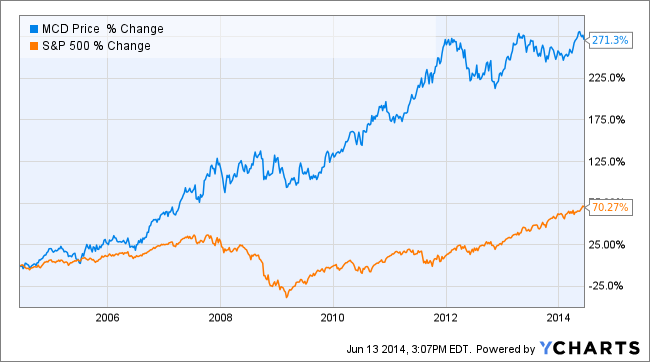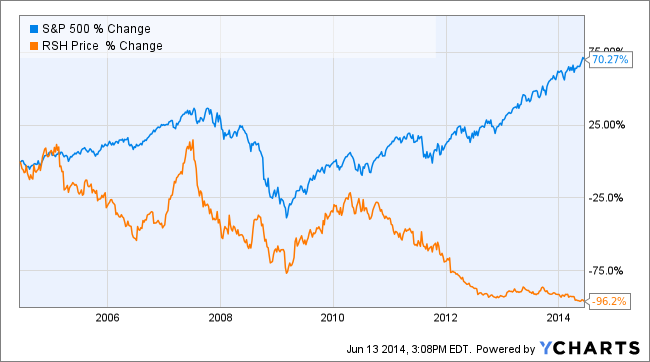Hold too little and you are at risk due to concentration
Hold too much and you are at risk due to “diworsification”
What is your magic number? How many stocks you hold in your portfolio? Is it related to the size of your portfolio? To the time you have to manage your fund? To the market? To the quality of companies at the moment?
There are several metrics influencing the decision of holding a few different shares in your portfolio or holding almost as many as an ETF. A reader, Bob Russo, recently commented on Dividend Stocks Rock asking how many stocks one investor should manage at one time. I answered quickly and took good note of his questions. Today, I’m going in-depth to explain my theory on stock management within a portfolio.
Size Does Matter
In my opinion, there is only one criteria to consider when it comes down to the number of stocks to hold in your portfolio: the size of your portfolio. This is why our dividend stocks portfolios vary the number of companies held by size and not by investor profile. This is why our conservative 25K portfolio shows the same number of stocks as our growth 25K portfolio. This is the same thing with American and Canadian portfolios. Even if the American market is bigger and has more investing opportunities at the moment, the number of stocks held is the same.
The number one reason why you want to hold more than one company in your portfolio is obviously for diversification. An investor who picked McDonald’s (MCD) 10 years ago might disagree as he earned 200% more than the S&P 500:
However, we can’t say the same thing about a Radioshack (RSH) shareholder who lost 96% of his investment:
These two examples are handpicked to show you the impact of a single decision in your portfolio. But a single bad decision would hurt your portfolio less if you hold 10, 15, 20 or 30 stocks. This is why all investors should never focus on one single stock. Canadian investors all know someone who lost a fortune on Nortel (previously NT) in 2000-2001.
The problem is you can’t buy 20 stocks when you only have $2,000 to invest
At DSR, we offer a starter portfolio for smaller investor. This portfolio is designed for those who have less than $10,000 but could start this portfolio with as little as $1,000. However, we suggest buying individual stocks with $1,000 only if you plan to systematically put money aside to invest more in the market. The main reason is linked to transaction fees.
Consider you only have $200 to start with. You can use $195 to buy your first stock and leave the extra $5 for transaction fees, the transaction fee represents 2.48% of your investment. This is the equivalent of a very expensive mutual fund. But it gets worse. To realize your profit, you will have to sell your shares for another $5. Therefore, a complete transaction (buy, hold and then sell) will represent almost 5% of your initial investment. This is a lot more than any mutual funds fees!
This is why buying 1 or 2 stocks with $1,000 is reasonable as long as you intend to add more $500 bills or $1,000 bills to your account to add more companies to your holdings. In the meantime, your portfolio is very risky in terms of volatility as you will depend on fewer stocks. Our starter portfolio only contains 4 stocks and would ideally start at $4,000 ($1,000 invested in each) to provide some kind of diversification.
In this kind of situation, I suggest taking few risks with your first purchases and go with blue chips in the consumer sector. Look for companies that are part of the aristocrat list (25 consecutive years of increasing dividends in the US) showing a wide range of products distributed in 100+ countries. We keep a track of the aristocrats list on DSR to help you choose from this great list. Another great option would be to buy a dividend ETF while you are building a larger portfolio. I personally prefer to start trading stocks right away, but ETFs could do a great job too as they hold many companies.
10 Stocks for $25,000
The way I’ve built my portfolio was to buy a company each time I had a little over $1,000 to invest. This enabled me to build a 10 stock portfolio with a value of roughly $15,000 back then. I like the fact that none of my stocks worth is more than 10% of my portfolio in order to provide me with a sound diversification. Plus, following 10 stocks is relatively easy and doesn’t take too much time.
Our 25K portfolio shows 10 stocks and we recommend you add more as your portfolio grows. The idea is to get to 20 stocks once you reach 100K. You don’t have to rush your purchases and you can easily reinvest more money in your existing holdings if you don’t find what you are looking for. Remember; investing is a long journey, you don’t have to rush anything in your first years. On the other hand, if you make the right decisions, you will benefit from an awesome growth in 30 years from now. Keep in mind that even if you are 50 and reading this, your life expectancy exceeds 80 so you will also benefit from this growth in 30 years!
With 10 stocks or so, you have about $2,500 to $3,000 to invest in each company. This is enough to make your trading fee costs lower than a mutual fund and you can receive about $20 in dividend payments each quarter per company. You won’t burn yourself studying the market while gaining experience in the investing world.
With a dozen stocks in hand, you can also have about one stock per sector or decide to overweight one for better expected returns. Here’s a quick list of all sectors:
Basic Materials
Consumer Cyclical
Consumer, Non-Cyclical
Energy
Financials
Healthcare
Industrial Goods
Real Estate
Services
Technology
Utilities
You can find several interesting dividend stocks in the consumer sectors (cyclical and non-cyclical) and among utilities, but there are good dividend payers in each sector.
Going from 20 to 30 Stocks + ETFs for Bigger Portfolios
Now that you have a sizeable portfolio (read over 100K), it’s time to increase the number of stocks in your holdings. As previously mentioned, this is a progressive method that you start when you have $1,000 and you keep adding stocks over time as your portfolio grows. You should have around 20 companies for 100K, meaning each investment is worth about 5% of your portfolio. If you have a few favorites (like I do), you can put a few more thousand in those but don’t go over 10% for any one company if you wish to keep volatility low.
After six months of operations at DSR, we decided to launch our 500K + portfolio. We have been asked several times after opening DSR to create a “wealth portfolio” for retired investors or those nearing retirement with over $500,000 to invest. At that time, we faced an important dilemma: do we increase the number of stocks to 50? Or do we keep it low and add ETFs?
We decided the latter. The 500K+ portfolio contains 30 stocks, which is more than enough to keep you busy managing your holdings but we added different types of ETFs to reduce the portfolio volatility. Once you reach this level, you are usually more concerned about investment stability than returns. This is why jumping from one stock to another seems less appealing compared to “safer” ETFs generating revenues.
Click here to visit our Dividend Stocks Rock Portfolio page.
Three Stocks or Three Times the Number of Shares of One Stock?
The number of stocks matters according to the size of your portfolio, but you must also consider how you invest them. For example, if I buy Royal Bank (TSE:RY), TD Bank (TSE:TD) and ScotiaBank (TSE:BNS), I just bought three very solid dividend stocks, but it’s also three solid banks. If this sector goes down, I have three companies following the same path. Are you better off buying three companies in the same sector or three times the amount into the best option among these three stocks?
If you have a small portfolio, I don’t think it’s a good idea to overweight a sector with several companies. In the end, if you want to buy a Canadian Bank, you might take a few more hours on your analysis and find the best one according to your dividend growth model. If you buy three of them, you do have more chances to have picked the right one, but you will have to spend three times the time used to follow one pick instead of three. It’s all about time efficiency!
If you want to buy three companies, you are better off buying three different sectors while building your portfolio. This reduces the volatility and increases your chance of picking an upcoming trend in a sector. I’ve seen too many investors focusing on a single sector (energy, financials and techno have been the most popular in the past 10 years) and I find it’s never a good idea to follow a major trend. I do hold stocks in energy, financial and the techno sectors, but I also pick in consumer cyclical, non-cyclical, industrial and other sectors as well.
What Should You Do If You Find Too Many Interesting Stocks?
You recently started investing and you have a few dozen stocks on your radar? You wonder how to buy them all as they are all great picks? This is probably because your minimum criteria are too loose and you are letting average companies to be listed on your radar.
Try being more strict with your stock filter and add more metrics. You’ll see how fast you can come from a list of 30 stocks to 8! Just think about it for a moment; how will you be able to follow 40 companies? If you are serious about investing, it means you read news and financial results about your holdings. Reading headlines for 40 companies is a crazy job. Trust me, this is what we do at DSR for our members and each time the earnings season starts, we block several hours in our weekly schedule to follow our picks.
If there is important news that slips past you about one of your picks, it could have an enormous impact on your year-end return. It is crucial you can trade stocks once it’s time to do it, not when it’s too late.
It All Comes Down to The Size of Your Portfolio & The Time You Have
The second major factor that will influence the number of stocks held in your account is probably the time (or interest) you want to devote to your holdings. Some people just love to read financial news and look forward the next economic topic on the internet. But we don’t all have this time on our hands. Many of us are stuck with a demanding job, a spouse that is working as hard as we are and a couple of kids with a schedule filled with activities (trust me, I know that I’m talking about, I have three kids of my own!).
This is exactly why we offer our services at DSR: to save you time managing your portfolio. Our bi-weekly newsletter cover all our stock picks during the earning seasons allowing you more time to do things other than reading the news about your beloved shares. Our portfolio models are “real life examples” meaning we trade from time to time and tell you when we proceed with a transaction. This is why you don’t have to spend all that time following all stocks; we do a great part of this job for you!
Check out what DSR can offer you and how we can help you improve your portfolio management.



